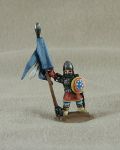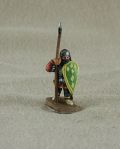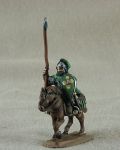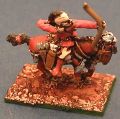Post Latin Conquest Byzantine (EPIROT)
| Navigation - HomePage - The Rise of Rome - Storm of Arrows - Immortal Fire - Legions Triumphant - Swords and Scimitars - Eternal Empire - Decline and Fall - Wolves from The Sea - Swifter Than Eagles |
Historical Overview Section
This era of Byzantine history covers the short period when the Later Crusaders occupied the city between 1204 and 1261. There are 4 principal states under this umbrella list.
Trebizond
The Empire of Trebizond was founded in early April 1204, when Alexios Komnenos, taking advantage of the preoccupation of the central Byzantine government with the encampment of the soldiers of the Fourth Crusade outside their walls seized the city of Trebizond with troops provided by his relative, Tamar of Georgia. Alexios Komnenos was a grandson of the last Komnenian Byzantine emperor. Trebizond initially controlled a contiguous area on the southern Black Sea coast between Soterioupolis and Sinope. David Komnenos, the younger brother of Alexios expanded the mini empire to the west, occupying first Sinope, then Paphlagonia and Heraclea Pontica until his territory bordered the Empire of Nicaea. This expansion was short-lived however: the territories west of Sinope were lost Nicaea by 1206, and Sinope itself fell to Seljuk Turk forces in 1214. Alexios' second son Manuel I (1238–1263) preserved internal security and acquired the reputation of a great commander, but the Empire was already losing outlying provinces to various Turkmen states, and found itself forced to pay tribute to the Seljuk Turks of Rum and then to the Mongols of Persia.
Nikaia
In 1204, Byzantine emperor Alexius V Ducas Murtzouphlos fled Constantinople after French crusaders invaded the city. Theodore I Lascaris, the son-in-law of Emperor Alexius III Angelus, was proclaimed emperor, but he too fled, to the city of Nicaea in Bithynia. Nicaea as the closest of the successor Byzantine states to Byzantium then attempt to re-establish the Byzantine Empire, although they lost to the Latin Greece state at Poemanenum and Prusa in 1204, but then capture much of northwestern Anatolia after the Latin Emperor Baldwin I had to defend against invasions from Kaloyan the Middle Bulgarian. Theodore also defeated an army from Trebizond, as well as other minor rivals, and in 1206 proclaimed himself emperor at Nicaea. Numerous truces and alliances were formed and broken over the next few years, as the Byzantine successor states, the Latin Greece Empire, the Middle Bulgarians, and the Seljuk Turks of Iconium (whose territory also bordered Nicaea) fought each other. Theodore died in 1222 to be succeeded by his son-in-law John III Ducas Vatatzes. John III expanded his territory to the shores of the Aegean and 1235 allied with Ivan Asen II the Middle Bulgarian. In 1242, the ilkhanid Mongols invaded Seljuk Turk territory to the east of Nicaea, eliminating the Seljuk threat to Nicaea and allowing John to ally with the Holy Roman Empire, defeated the Middle Bulgarians and surround the Empire of Latin Greece. John III’s son faced new invasions from the Bulgarians in Thrace, but successfully defended the territory. Epirus was revolting and allied with Manfred of Sicily. In 1258 general Michael Palaeologus became regent, then proclaimed himself co-emperor (as Michael VIII) in 1259, and soon defeated a combined invasion by Manfred, the Despot of Epirus, and the Latin Prince of Achaea at the Battle of Pelagonia. In 1260, Michael began the assault on Constantinople itself, allied with Genoa. In July of 1261, as most of the Latin army was fighting elsewhere his general Alexius was able to convince the guards to open the gates of the city. Michael was recognized as emperor a few weeks later, restoring the Byzantine Empire. Achaea was soon recaptured, but Trebizond and Epirus remained independent Byzantine Greek states.
Epiros
The Despotate was founded in 1205 by Michael Komnenos Doukas, a cousin of the Byzantine emperors Isaac II Angelos and Alexios III Angelos. Epirus soon became the new home of many Greek refugees from Constantinople, Thessaly, and the Peloponnese, and Michael was described as a second Noah, rescuing men from the Latin flood. an early ruler of Latin Greece Henry of Flanders demanded that Michael submit to the Latin Empire, which he did, at least nominally, by allowing his daughter to marry Henry's brother Eustace in 1209 but Michael did not honour this alliance, assuming that mountainous Epirus would be mostly impenetrable by any Latins with whom he made and broke alliances! Michael also turned his attention to capturing other strategically important Latin-held towns, including Larissa and Dyrrhachium. He also took control of the ports on the Gulf of Corinth. In 1214 he captured Corcyra from Venice, but was assassinated later that year and was succeeded by his half-brother Theodore. Theodore Komnenos Doukas immediately attacked Thessalonica, and fought with the Middle Bulgarians along the way. Henry of Flanders died on the way to counterattack, and in 1217 Theodore captured his successor Peter of Courtenay. The Latin Greece Empire, however, became distracted by the growing power of Nicaea and could not stop Theodore from capturing Thessalonica in 1224. In 1225, after John III Doukas Vatatzes of Nicaea had taken Adrianople, Theodore arrived and in turn took it from him. Theodore also allied with the Middle Bulgarians and drove the Latins out of the Thrace. In 1227 Theodore crowned himself Byzantine emperor, although this was not recognized by most Greeks. In 1230 Theodore broke the truce with Bulgaria, hoping to remove Ivan Asen II, who had held him back from attacking Constantinople but in the battle of Klokotnitsa (near Haskovo in Bulgaria) the Bulgarian emperor defeated, captured, and later blinded Theodore, leaving his brother Manuel Komnenos Doukas to take over in Thessalonica, while their nephew Michael II Komnenos Doukas took over Epirus. Theodore was released in 1237, overthrew his brother and set up his son John Komnenos Doukas as ruler of Thessalonica! But Thessalonica never regained its power after the battle of Klokotnitsa and Demetrios Angelos Doukas lost Thessalonica to Nicaea in 1246, so Michael II of Epirus allied with the Latins against the Nicaeans. In 1248 John III Doukas Vatatzes of Nicaea forced Michael to recognize him as emperor, and officially recognized him in turn as Despote in Epirus. Michael revolted in 1257 revolted, defeating a Nicaean army. As Michael marched on Thessalonica, he was attacked by King Manfred of Sicily, who conquered Albania and Corcyra. However, Michael immediately allied with him by marrying his daughter Helena to him by the side of the road in a short but very touching civil ceremony. After Theodore II died, Michael, Manuel, and William II ALL fought the new Nicaean emperor Michael VIII Palaiologos. The alliance was very unstable and in 1259 William was captured at the disastrous Battle of Pelagonia. Michael VIII went on to capture Michael II's capital of Arta, leaving Epirus with only Ioannina and Vonitsa.
The Byzantine Armies in order
- Early Byzantine : 493 - 550 The Eastern Roman Empire & Belisarius on the offensive - Mixed & Bw/Sw Cv units and "legionaries" - D&F
- Maurikian Byzantine : 550 - 650 Loss of Africa, The Strategikon, War with Persia & The Arabs - Good quality Ln & Bw/Sw Cv, Mixed Skoutatoi but no LH - D&F
- Thematic Byzantine : 650 - 963 The Thematic System, Tagmatic units fighting the Caliphates - Mixed units & Bw/Sw Cv, Average & Poor units, Cataphracts - D&F
- Nikephorian Byzantine : 963 - 1071 Basil bashes the Bulgars, Normans conquer Italy, Manzikert loss to the Turks - Bw* or Ln Cavalry, Varangians, lots of mixed spearmen & some Normans - D&F
- Komnenan Byzantine : 1071 - 1204 Manzikert to Fall of Constantinople to the Crusaders - Lancer Cv, some KN, Varangians - S&S
- Post Latin Conquest Byzantine : 1204 - 1261 Nikaia, Epiros, Trebizond vs the Latin Kingdoms - Frankish Kn, lots of archers, - S&S
- Late Byzantine : 1261 - 1461 Byzantium, Epirus, Morea & Trebizond until their fall to the Turks - Cv Lancers, 4 Kn, lots of archers - EE
Links
User-contributed links about this army:
- put the link text readers will see in here write some more detail about the link here
- put the link text readers will see in here write some more detail about the link here
- put the link text readers will see in here write some more detail about the link here
Allied Contingents
- Byzantine, Post Latin Conquest (Only Trebizond) ; Georgian Dates: Any Swords and Scimitars page 16 Lancers pre 1118, Bw/Sw afterwards plus 4 LH make the only minimums in this textbook ally. Foot in cheap 4-strong units is also nice
- Byzantine, Post Latin Conquest (Only Nikia); Turk, Seljuk Dates: After 1258 Swords and Scimitars page 18 Bw/Sw Superior Armoured Cavalry, and Bw/Sw LH or Protected Cavalry to support - fairly standard Arab ally
- Byzantine, Post Latin Conquest (Only Nikia); Cuman Dates: After 1242 Swords and Scimitars page 21 Can be fielded just as lots of Bw/Sw LH, with optional Armoured Cv to stiffen it
- Byzantine, Post Latin Conquest (Only Epiros); Bulgarian, Middle Dates: Before 1216 Swords and Scimitars page 42 Lancer cavalry, supported by the usual LH/Cv Bw/Sw mix. Cheap foot units in 4's to help pad things out if needed
- Byzantine, Post Latin Conquest (Only Nikia) ; Bulgarian, Middle Dates: Before 1237 Swords and Scimitars page 42 Lancer cavalry, supported by the usual LH/Cv Bw/Sw mix. Cheap foot units in 4's to help pad things out if needed
- Byzantine, Post Latin Conquest (Only Epiros); Byzantine, Post Latin Conquest (Thessalians) Dates: 1259 Swords and Scimitars page 46 Drilled average lancers are compulsary, there's LH to support them, but the proper knights are the best bit.
- Byzantine, Post Latin Conquest (Only Nikia) ; Byzantine, Post Latin Conquest (Thessalians) Dates: 1260 Swords and Scimitars page 46 Drilled average lancers are compulsary, there's LH to support them, but the proper knights are the best bit.
- Byzantine, Post Latin Conquest (Only Epiros); Greece, Latin (Achaian Franks) Dates: 1259 Swords and Scimitars page 49 Up to 8 proper knights, lots of bits and pieces of infantry bowmen and crossbows, and 4 optional lancer cavalry.
Tournament Results with this army
6 / 62 Post Latin Conquest Byzantine Britcon 2008 15mm (open)
4 / 14 Post Latin Conquest Byzantine Northern League 2008 R4 (open)
15mm Manufacturers supplying figures for this army
You can see some of the figures in the Ancients Photo Gallery also on this site
Many manufacturers produce just one "Byzantine" range, not specifying which era they are for (but most are Maurkikian era I suspect). All generic "Byzantine" ranges have been listed here, together with any specifically noted for particular eras. For Latin or other allied troops, use Crusader or other knights of a similar timeframe. 700AD - in the Thematic list - is as good a date as any for round shields to start to change over to kite shields. The troops in this list are likley to be slightly scruffier Komnenans with a few Norman/Frankish types as well.

|

|

|
|

|
- Essex Miniatures - Several Byzantine ranges. 8 Maurikians, 7 Thematics, 10 Nikephorians & 5 Generic Psiloi for all era in their Ancients ranges.
- Donnington 22 Byzantines, including a Belisarius general figure (a clue to them being fairly early maybe..) plus a 23-strong C12-13 range
- Museum Miniatures - 17 Byzantines, reasonably early period.
- Gladiator Miniatures by Fighting 15's (Previously Black Hat) - 10 Komnenans in their Crusades range
- Old Glory 15's - 12 Belisarians, and 22 codes in a "7th-13th Century Byzantine" range
- Minifigs - 21 Byzantines, from C7-C11 in their Dark Ages range, 5 more C11-13 ones in their Crusades range
- Irregular Miniatures - 21 Byzantines, with Nikephorian, Tagmatic, Thematic, Maurikian and Belisarian cavalry listed as well as CC7-10 oval-shield foot and C11-13 kite-shielded foot
- Tin Soldier 21 10th & 11th Century Byzantines
- Battle Line Miniatures (NZ) Same range as Isarus
- Alain Touller - almost 20 Byzantines with both kite and round shields
- Isarus - sold by 15mm.co.uk 18 Byzantines, kite-shielded lancers and round-shielded bowmen
- Outpost Wargame Services 10 Crusade-era Byzantines
- Khurasan Miniatures - 20-odd Nikephorian Byzantines (kite shield infantry)
- Viking Forge - Generic range of 20 or so Byzantines, Tagmatic and Thematic cavalry are listed
- 50 Paces/Miniature Wars - 10 -strong Belisarian (early) range
- QRF Models MK range with 13th century knights, and foot for allies and mercenaries.
User contributed lists
This is the Army philqw78 used at Britcon 2008
philqw78 got most of the figures for this list from e-bay
Epirot - Post Latin Conquest Byzantine
- 4xTC
- 4 Byzantine Cavalry - Cav-Armd-Av-Dr- - - Lancer - Swordsmen
- 4 Byzantine Cavalry - Cav-Armd-Av-Dr- - - Lancer - Swordsmen
- 4 Frankish Knights - Kn - HA - Sup - Dr - - - lancer - Swordsmen
- 4 Frankish Knights - Kn - HA - Sup - Dr - - - lancer - Swordsmen
- 4 Skythikon - LH - UP - Av - UD - Bow - - - Swordsmen
- 4 Skythikon - LH - UP - Av - UD - Bow - - - Swordsmen
- 4 Skythikon - LH - UP - Av - UD - Bow - - - Swordsmen
- 4 Skythikon - LH - UP - Av - UD - Bow - - - Swordsmen
- 4 Albanian Cavalry - LH - UP - Av - UD - Jav - Lt Sp - Swordsmen
- 6 Regular Archers - LF - UP - Av - Dr - Bow - - - -
- 6 Irregular Archers - LF - UP - Av - Dr - Bow - - - -
- 4 Frankish Knights - Kn - HA - Sup - UD - - - lancer - Swordsmen
12 BG. PBI of +2.
Reasons for this army design
Decent LH with support. The LH can stand up to other LH armies, especially with the support of the Byzantine cavalry.
Shock effect. 2 of the Knight BG are drilled so I can get them into the right place and hit very hard, the 3rd BG going down last so it was closer to the right place. I put the LF down last as there was no other foot to support it and I didn't want to waste any mounted on that job.
Result
3 Big wins.
- Carthagininians - lots of slow foot that I could hit when and where I wanted, and not enough mounted to cope, but enough to make a good target
- Principate Romans - He didn't get enough terrain to hold off my outflanking and only had two units of Cav to stop it.
- Early Aechemenid Persian - He got a lot more terrain and I was a bit impetuous to start with but the three of his generals he put into combat with his hoplites against my Knights all died, which really didn't help him.
2 Draws
- Sassanids - I spent too long trying to avoid his elephants, due to my Kn deploying early. Got into his Cav in the end. slight loss for me, though we both ran out of time.
- Dominate Roman - 19 small BG like a firework display trying to force me into charges he could intercept. Had played this the previous day and learnt from the experience. Special mention to my LH BG who were in combat from the second turn to the end of the game.
1 BIG loss
- Dominate Roman - 19 small BG. As above. Late Saturday and I sat stunned like a rabbit in headlights. Learnt from the game though
What Would I Change
Probably try and get an IC by dropping the third TC. Drop the Kn to undrilled and place them last. Their being drilled only helped by making it slightly easier to avoid charging if I was going be interceppted. This should then let me swap a BG of LH for another of Lancers.
eBay Listings
UK Bookstore
EPIROT